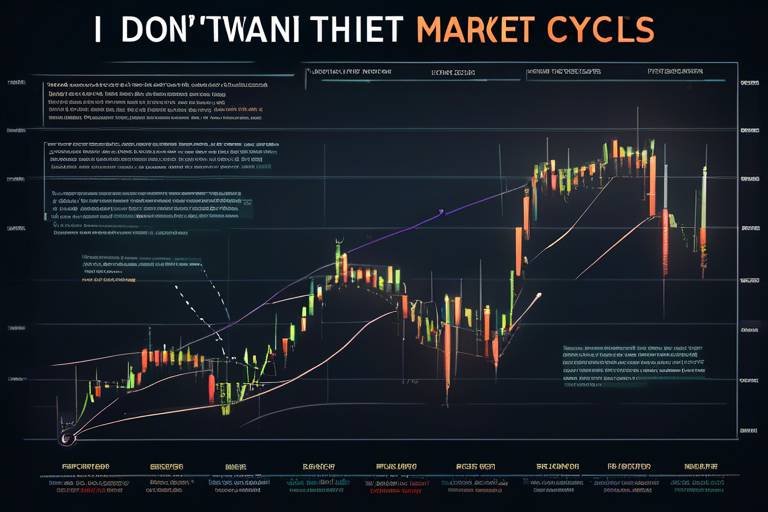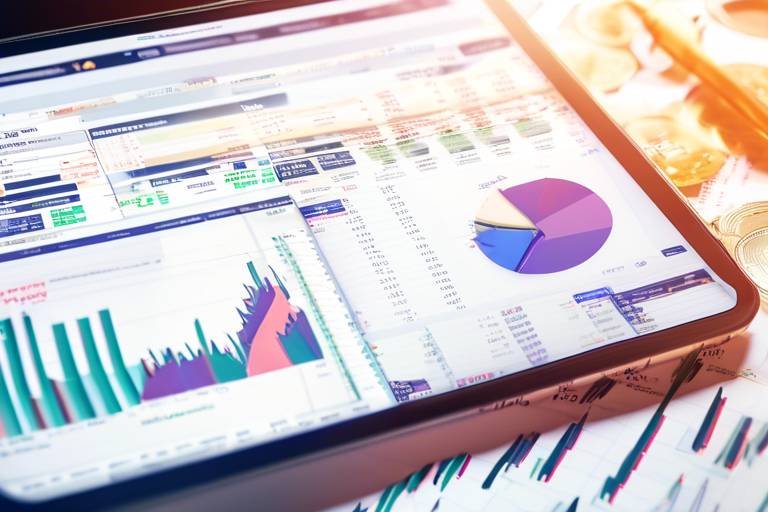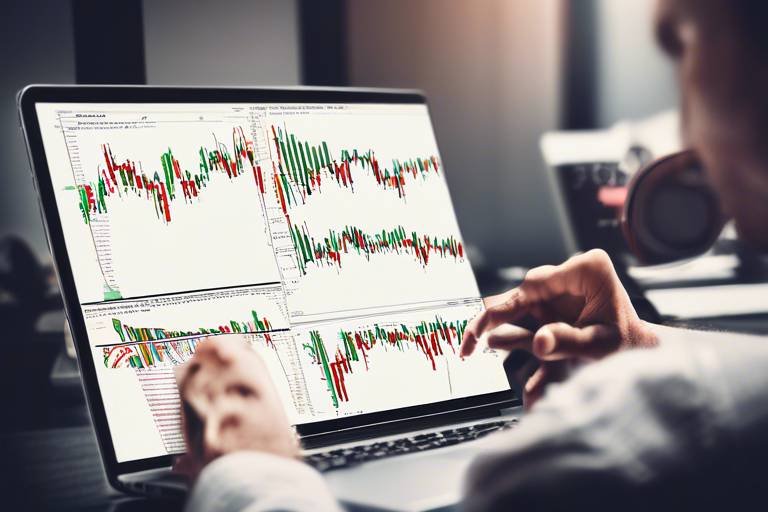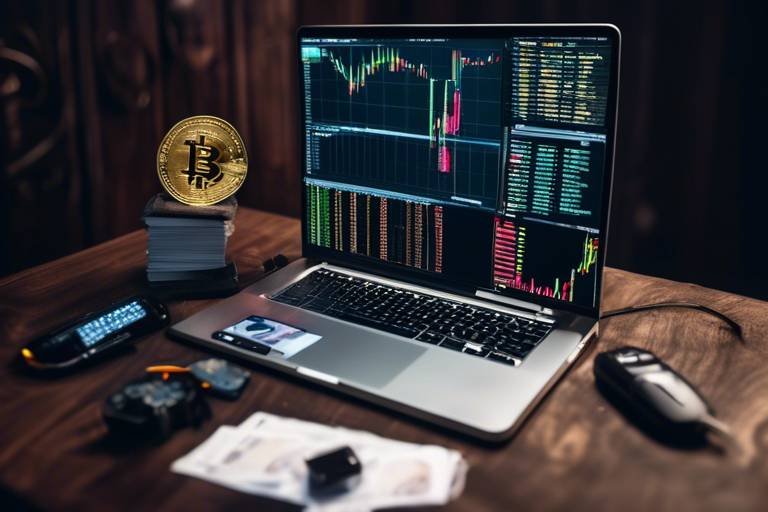The Importance of Setting Trading Alerts
In the fast-paced world of trading, where every second counts, setting trading alerts can be the difference between a missed opportunity and a profitable decision. Imagine you're at a concert, completely immersed in the music, but you know that your favorite song is about to play. Wouldn't it be great if someone could tap you on the shoulder just in time to catch that moment? Trading alerts serve a similar purpose in the financial markets; they act as your personal assistant, nudging you when it's time to take action.
Trading alerts are not just notifications; they are your lifeline in a sea of market noise. They help you stay informed about critical price movements, trends, and significant market events without the need to constantly monitor your screens. By leveraging these alerts, you can enhance your trading strategy, allowing you to focus on making informed decisions rather than getting lost in the chaos of the market.
Moreover, the importance of setting trading alerts extends beyond just convenience. They can significantly improve your reaction times, enabling you to act swiftly in response to market changes. Picture this: a stock price suddenly surges, and if you’ve set an alert, you’ll be one of the first to know. This can help you seize opportunities before they vanish, much like catching a wave just as it begins to crest.
Additionally, trading alerts can help reduce emotional trading. Emotions can cloud judgment, leading to impulsive decisions that can jeopardize your investment strategy. With alerts, you receive objective notifications based on market data, which encourage you to stick to your trading plan. Think of it as having a compass in the wilderness; it guides you back to your path when emotions try to lead you astray.
In summary, trading alerts are essential tools for any trader looking to maximize their investment opportunities. They not only keep you informed but also empower you to make timely, rational decisions. As you dive deeper into the world of trading, remember that setting effective alerts can be your ticket to navigating the markets with confidence and precision.
- What types of alerts can I set? You can set price alerts, volume alerts, and technical alerts, each serving different trading strategies.
- How do I set alerts on my trading platform? Most platforms have built-in alert systems; familiarize yourself with these tools to effectively set your alerts.
- Can alerts help reduce emotional trading? Yes, alerts provide objective notifications that encourage disciplined trading rather than impulsive decisions.

Understanding Trading Alerts
This article explores the significance of trading alerts, how they can enhance trading strategies, and tips for setting effective alerts to maximize investment opportunities.
Trading alerts are notifications that inform traders about specific market conditions, serving as essential tools in the fast-paced world of trading. Imagine being a captain of a ship navigating through turbulent waters; without a reliable compass or radar, you risk losing your way. Similarly, trading alerts act as your navigational aids, guiding you through the unpredictable seas of the financial markets. They help in making timely decisions, ensuring that traders don’t miss critical price movements or trends that could significantly impact their investments.
When you set a trading alert, you essentially define a specific condition under which you want to be notified. This could be a price point, a percentage change, or even a combination of technical indicators. The beauty of trading alerts lies in their ability to keep you informed without requiring you to constantly monitor the market. You can go about your day, whether that means spending time with family, working on other projects, or even enjoying a hobby, all while knowing that you will be alerted when it’s time to take action.
There are several ways trading alerts can be set up, depending on the platform you use. Most trading platforms come equipped with built-in alert systems, allowing you to customize your notifications based on your trading strategy. For instance, you might prefer to receive alerts via email, SMS, or even through the platform's app. This flexibility means that you can choose the method that works best for you, ensuring that you never miss an opportunity.
In addition to price alerts, which notify you when an asset reaches a specified price point, there are also volume alerts and technical alerts. Each of these alerts serves a unique purpose and caters to different trading strategies. Understanding the various types of alerts available to you can significantly enhance your trading experience and improve your overall strategy.
Overall, trading alerts are not just a convenience; they are a necessity for anyone serious about trading. By leveraging these notifications, you can make more informed decisions, respond quickly to market changes, and ultimately increase your chances of success in the trading arena.
There are various types of trading alerts, including price alerts, volume alerts, and technical alerts. Each serves a unique purpose, catering to different trading strategies and preferences.
Price alerts notify traders when an asset reaches a specified price point. This allows traders to capitalize on buying or selling opportunities without constantly monitoring the market.
Volume alerts inform traders of significant changes in trading volume, indicating potential market movements. High volume often precedes price changes, making these alerts crucial for informed trading decisions.
Setting trading alerts provides numerous advantages, such as improved reaction times, reduced emotional trading, and enhanced ability to track multiple assets simultaneously, leading to more informed investment strategies.
With alerts, traders can respond quickly to market changes, minimizing the risk of missing profitable trades. This swift action is vital in fast-paced trading environments.
Alerts help mitigate emotional decision-making by providing objective notifications. This encourages traders to stick to their strategies rather than reacting impulsively to market fluctuations.
Setting effective trading alerts involves choosing the right parameters and platforms. Traders should consider their specific goals and market conditions to create alerts that truly benefit their strategies.
Selecting appropriate parameters for alerts is crucial. Traders should analyze historical data and market trends to set realistic and actionable alert thresholds.
Most trading platforms offer built-in alert systems. Familiarizing oneself with these tools can enhance the effectiveness of alerts and streamline the trading process.
Q: What are trading alerts?
A: Trading alerts are notifications that inform traders about specific market conditions, helping them make timely decisions.
Q: How do I set trading alerts?
A: You can set trading alerts through most trading platforms by defining specific conditions like price points or volume changes.
Q: Why are trading alerts important?
A: They help traders respond quickly to market changes, reduce emotional trading, and manage multiple assets efficiently.
Q: Can I receive alerts via mobile?
A: Yes, most trading platforms allow you to receive alerts through various channels, including mobile notifications.

Types of Trading Alerts
When it comes to trading, having the right tools at your disposal can make all the difference. One of the most essential tools in a trader's arsenal is the trading alert. These alerts come in various forms, each designed to cater to specific trading strategies and preferences. Understanding the different types of trading alerts can significantly enhance your trading experience, allowing you to make informed decisions without getting bogged down by constant market monitoring.
At the core, trading alerts can be categorized into three main types: price alerts, volume alerts, and technical alerts. Each of these serves a unique purpose and can be utilized in different market conditions to optimize trading strategies. Let’s delve deeper into each type:
Price alerts are perhaps the most straightforward type of trading alert. They notify traders when an asset reaches a specified price point, which is particularly useful for those looking to buy low and sell high. Imagine you have your eye on a stock that you believe is undervalued. Instead of constantly checking the price, you can set a price alert that will ping you when it hits your target. This not only saves time but also ensures that you never miss a buying opportunity that aligns with your trading strategy.
Next, we have volume alerts. These notifications inform traders of significant changes in trading volume, which can be a precursor to price movements. High trading volume often indicates strong interest in an asset, and it can signal potential volatility. For instance, if a stock suddenly experiences a surge in volume, it might be worth investigating further. Volume alerts enable traders to stay ahead of the curve, allowing them to capitalize on potential market shifts before they happen.
Lastly, technical alerts are based on specific technical indicators or chart patterns. These alerts can be tied to various metrics, such as moving averages, RSI (Relative Strength Index), or MACD (Moving Average Convergence Divergence). For traders who rely heavily on technical analysis, setting alerts for these indicators can be incredibly beneficial. It allows them to react promptly to market conditions that align with their trading strategies. For example, if a stock crosses above its 50-day moving average, a technical alert can notify the trader to consider entering a position.
In summary, understanding the different types of trading alerts can empower you as a trader. By leveraging price, volume, and technical alerts, you can enhance your trading strategies and make more informed decisions. The right alerts can help you navigate the complexities of the market with greater confidence and efficiency.
Q: How do I set up trading alerts?
A: Most trading platforms offer built-in alert systems. You can usually find the option to create alerts in the settings or tools menu. Simply choose the type of alert you want, set the parameters, and activate it.
Q: Can I set multiple alerts for the same asset?
A: Yes, you can set multiple alerts for the same asset, each with different parameters. This is particularly useful if you want to be notified at various price points or volume levels.
Q: Are trading alerts free?
A: Many trading platforms offer free alert services, but some may charge for advanced features or additional alerts. It’s best to check with your specific trading platform for details.
Q: How can trading alerts improve my trading performance?
A: Trading alerts can improve your performance by providing timely notifications that help you make quick decisions, reduce emotional trading, and keep you informed about market movements without the need for constant monitoring.

Price Alerts
Price alerts are a game changer for traders, providing a lifeline in the fast-paced world of trading. Imagine you're a surfer waiting for the perfect wave; you wouldn't want to miss that moment just because you were looking the other way. Similarly, price alerts ensure that you're always in the loop, notifying you when an asset hits a predetermined price point. This feature allows you to capitalize on buying or selling opportunities without being glued to your screen all day long.
Setting price alerts can be as simple as entering a specific price level into your trading platform. Once that price is reached, you receive a notification via your preferred method—be it a text message, email, or app alert. This means you can go about your day, whether you're at work, running errands, or even enjoying a coffee break, and still be in control of your investment strategy.
But how do you know what price points to set for your alerts? This is where a bit of analysis comes into play. Traders often look at historical price movements, resistance and support levels, and market trends to determine the most strategic alert thresholds. For example, if a stock has repeatedly bounced back from a certain price level, setting an alert just below that level could provide a timely opportunity to buy in before the price rebounds.
Moreover, price alerts can be particularly beneficial during earnings seasons or major news announcements that can cause significant price fluctuations. By being alerted to these changes, you can make informed decisions quickly, potentially maximizing your profits. However, it's crucial to remember that alerts should be part of a broader trading strategy. Relying solely on price alerts without understanding market dynamics can lead to missed opportunities or unnecessary losses.
In conclusion, price alerts are not just a luxury; they are a necessity for anyone serious about trading. They empower you to act swiftly and decisively, transforming how you approach the markets. So, whether you're a seasoned trader or just starting, integrating price alerts into your trading routine can significantly enhance your ability to seize opportunities as they arise.
- What are price alerts? Price alerts are notifications that inform traders when an asset reaches a specified price point, allowing them to make timely trading decisions.
- How do I set up a price alert? You can set up a price alert through your trading platform by entering the desired price level for the asset you are monitoring.
- Can I set multiple price alerts? Yes, most trading platforms allow you to set multiple price alerts for different assets or price levels.
- Are price alerts reliable? While price alerts are a helpful tool, it's essential to combine them with thorough market analysis for the best results.

Volume Alerts
Volume alerts are an essential tool for traders who want to stay ahead of the market. By notifying traders of significant changes in trading volume, these alerts can signal potential price movements that may be on the horizon. Think of volume alerts as your market radar; they help you detect shifts in activity that could lead to profitable opportunities. For instance, a sudden surge in volume often indicates that something important is happening with an asset—whether it's a breakout, a reversal, or simply increased interest from other traders.
Understanding the relationship between volume and price is crucial. High trading volume can precede significant price changes, making volume alerts invaluable for traders looking to make informed decisions. When you receive a volume alert, it’s like receiving a friendly nudge, reminding you to pay attention to the asset in question. This alert can help you decide whether to enter a trade or adjust your existing positions. Moreover, volume alerts can prevent you from being caught off-guard by sudden market shifts, allowing you to act swiftly and strategically.
To illustrate the importance of volume alerts, consider the following table that highlights how volume changes can correlate with price movements:
| Volume Change | Potential Market Impact | Actionable Insight |
|---|---|---|
| Increase of 50% or more | Potential breakout or trend reversal | Consider entering or exiting positions |
| Decrease in volume | Market indecision or consolidation | Hold positions, wait for clarity |
| Consistent high volume over days | Strong bullish or bearish sentiment | Evaluate long-term strategies |
In summary, volume alerts are not just notifications; they are powerful indicators that can enhance your trading strategy. By setting these alerts, you can ensure that you remain informed about market dynamics, enabling you to make timely and strategic decisions. Whether you're a day trader or a long-term investor, incorporating volume alerts into your trading routine can significantly improve your chances of success.
- What are volume alerts? Volume alerts notify traders of significant changes in trading volume, indicating potential market movements.
- Why are volume alerts important? They help traders identify trends and make informed decisions based on market activity.
- How can I set volume alerts? Most trading platforms allow you to set volume alerts based on your chosen parameters.
- Can volume alerts predict price movements? While they can indicate potential price changes, they should be used in conjunction with other analysis tools for best results.

Benefits of Setting Alerts
This article explores the significance of trading alerts, how they can enhance trading strategies, and tips for setting effective alerts to maximize investment opportunities.
Trading alerts are notifications that inform traders about specific market conditions. They help in making timely decisions, ensuring that traders don’t miss critical price movements or trends.
There are various types of trading alerts, including price alerts, volume alerts, and technical alerts. Each serves a unique purpose, catering to different trading strategies and preferences.
Price alerts notify traders when an asset reaches a specified price point. This allows traders to capitalize on buying or selling opportunities without constantly monitoring the market.
Volume alerts inform traders of significant changes in trading volume, indicating potential market movements. High volume often precedes price changes, making these alerts crucial for informed trading decisions.
Setting trading alerts provides numerous advantages that can significantly transform a trader's approach to the market. One of the most notable benefits is improved reaction times. Imagine being able to respond to market changes as swiftly as a hawk swoops down on its prey. With alerts, traders can seize opportunities that may otherwise slip through their fingers. This quick response is particularly vital in fast-paced trading environments where every second counts.
Another compelling advantage is the reduction of emotional trading. Trading can often feel like an emotional rollercoaster, with market fluctuations stirring up feelings of anxiety and excitement. Alerts act as a calming presence, providing objective notifications that encourage traders to adhere to their strategies rather than reacting impulsively. This disciplined approach not only enhances trading performance but also fosters a healthier mindset towards investing.
Additionally, alerts enhance a trader's ability to track multiple assets simultaneously. In today's diverse financial landscape, keeping an eye on various investments can be overwhelming. By setting alerts, traders can focus on their core strategies while still being informed about significant changes across their portfolio. This multi-tasking capability allows for a more comprehensive investment strategy, ultimately leading to better decision-making.
To summarize, the benefits of setting trading alerts include:
- Improved Reaction Times: Quickly respond to market changes.
- Reduced Emotional Trading: Stick to strategies without emotional interference.
- Enhanced Tracking: Monitor multiple assets with ease.
Setting effective trading alerts involves choosing the right parameters and platforms. Traders should consider their specific goals and market conditions to create alerts that truly benefit their strategies.
Selecting appropriate parameters for alerts is crucial. Traders should analyze historical data and market trends to set realistic and actionable alert thresholds.
Most trading platforms offer built-in alert systems. Familiarizing oneself with these tools can enhance the effectiveness of alerts and streamline the trading process.
Q: What are trading alerts?
A: Trading alerts are notifications that inform traders about specific market conditions, helping them make timely decisions.
Q: How do trading alerts enhance my trading strategy?
A: They improve reaction times, reduce emotional trading, and allow for better monitoring of multiple assets.
Q: Can I customize my trading alerts?
A: Yes, most platforms allow you to set specific parameters for your alerts based on your trading strategy.
Q: Are trading alerts available on all trading platforms?
A: While most modern trading platforms offer alert systems, the features may vary, so it's good to check your platform's capabilities.

Improved Reaction Times
This article explores the significance of trading alerts, how they can enhance trading strategies, and tips for setting effective alerts to maximize investment opportunities.
Trading alerts are notifications that inform traders about specific market conditions. They help in making timely decisions, ensuring that traders don’t miss critical price movements or trends.
There are various types of trading alerts, including price alerts, volume alerts, and technical alerts. Each serves a unique purpose, catering to different trading strategies and preferences.
Price alerts notify traders when an asset reaches a specified price point. This allows traders to capitalize on buying or selling opportunities without constantly monitoring the market.
Volume alerts inform traders of significant changes in trading volume, indicating potential market movements. High volume often precedes price changes, making these alerts crucial for informed trading decisions.
Setting trading alerts provides numerous advantages, such as improved reaction times, reduced emotional trading, and enhanced ability to track multiple assets simultaneously, leading to more informed investment strategies.
Imagine being in a race where every second counts. In the world of trading, reaction time can make the difference between a profitable trade and a missed opportunity. With trading alerts, you can respond swiftly to market changes, ensuring that you don’t miss out on those critical moments that could lead to significant gains. By receiving immediate notifications on market movements, traders can act quickly—whether it’s to buy an asset that’s just dipped to a favorable price or to sell before a downturn.
For instance, consider a scenario where a trader is monitoring a stock that has shown a steady upward trend. Suddenly, a price alert notifies them that the stock has reached a new high. Without alerts, the trader might have missed this opportunity, but with them, they can jump in and capitalize on the momentum. This swift action is vital in fast-paced trading environments where every moment counts.
Additionally, trading alerts can help you manage multiple assets without feeling overwhelmed. Picture this: you’re tracking five different stocks across various sectors. Instead of staring at charts all day, you can set alerts for each stock based on your trading strategy. When an alert triggers, it’s like having a personal assistant whispering in your ear, “Hey, it’s time to take action!” This not only improves your efficiency but also enhances your overall trading experience.
In summary, improved reaction times through trading alerts allow traders to:
- Seize opportunities as they arise.
- Minimize losses by acting before market shifts.
- Manage multiple assets effectively without constant monitoring.
By integrating alerts into your trading strategy, you equip yourself with the tools necessary for navigating the ever-changing landscape of the market.
Setting effective trading alerts involves choosing the right parameters and platforms. Traders should consider their specific goals and market conditions to create alerts that truly benefit their strategies.
Selecting appropriate parameters for alerts is crucial. Traders should analyze historical data and market trends to set realistic and actionable alert thresholds.
Most trading platforms offer built-in alert systems. Familiarizing oneself with these tools can enhance the effectiveness of alerts and streamline the trading process.
1. What are trading alerts?
Trading alerts are notifications that inform traders of specific market conditions, helping them make timely decisions.
2. How do I set trading alerts?
You can set trading alerts through various trading platforms by selecting price points, volume changes, or technical indicators that are relevant to your trading strategy.
3. Can trading alerts help reduce emotional trading?
Yes, trading alerts provide objective notifications, which can help traders stick to their strategies and minimize impulsive decisions.
4. Are there different types of trading alerts?
Yes, the main types of trading alerts include price alerts, volume alerts, and technical alerts, each serving a unique purpose in trading strategies.

Reduced Emotional Trading
This article explores the significance of trading alerts, how they can enhance trading strategies, and tips for setting effective alerts to maximize investment opportunities.
Trading alerts are notifications that inform traders about specific market conditions. They help in making timely decisions, ensuring that traders don’t miss critical price movements or trends.
There are various types of trading alerts, including price alerts, volume alerts, and technical alerts. Each serves a unique purpose, catering to different trading strategies and preferences.
Price alerts notify traders when an asset reaches a specified price point. This allows traders to capitalize on buying or selling opportunities without constantly monitoring the market.
Volume alerts inform traders of significant changes in trading volume, indicating potential market movements. High volume often precedes price changes, making these alerts crucial for informed trading decisions.
Setting trading alerts provides numerous advantages, such as improved reaction times, reduced emotional trading, and enhanced ability to track multiple assets simultaneously, leading to more informed investment strategies.
With alerts, traders can respond quickly to market changes, minimizing the risk of missing profitable trades. This swift action is vital in fast-paced trading environments.
One of the most significant benefits of setting trading alerts is the reduction of emotional trading. When traders rely on their instincts or gut feelings, they can often make decisions that are not aligned with their overall strategy. This is where alerts come in handy. By providing objective notifications, alerts help traders stick to their plans rather than reacting impulsively to market fluctuations. For instance, consider a trader who has set an alert for a stock that they believe is undervalued. When the alert triggers, they can evaluate the situation based on their predetermined criteria rather than succumbing to fear or greed.
Moreover, emotional trading often leads to overtrading, where traders buy and sell excessively based on fleeting emotions. By using alerts, traders can avoid the pitfall of constantly checking prices and feeling pressured to act. Instead, they can focus on their analysis and strategy. This leads to a more disciplined approach, which is crucial for long-term success in the market.
In essence, trading alerts serve as a safety net, allowing traders to maintain their composure and make decisions based on data rather than emotions. This disciplined approach not only enhances trading performance but also contributes to a healthier mental state, making the trading journey more enjoyable.
Setting effective trading alerts involves choosing the right parameters and platforms. Traders should consider their specific goals and market conditions to create alerts that truly benefit their strategies.
Selecting appropriate parameters for alerts is crucial. Traders should analyze historical data and market trends to set realistic and actionable alert thresholds.
Most trading platforms offer built-in alert systems. Familiarizing oneself with these tools can enhance the effectiveness of alerts and streamline the trading process.
- What are trading alerts? Trading alerts are notifications that inform traders about specific market conditions, helping them make timely decisions.
- How do trading alerts improve trading strategies? They allow traders to respond quickly to market changes, reducing emotional trading and enhancing the ability to track multiple assets.
- What types of trading alerts are available? Common types include price alerts, volume alerts, and technical alerts, each serving different purposes.
- Can I set alerts on any trading platform? Most trading platforms offer built-in alert systems, but features may vary, so it's essential to explore your platform's capabilities.

How to Set Effective Alerts
Setting effective trading alerts is not just about clicking buttons and waiting for notifications; it’s an art that can significantly enhance your trading strategy. To get the most out of your alerts, you need to think critically about your trading goals and the market conditions. First and foremost, you should determine what you want to achieve with these alerts. Are you looking to buy low and sell high? Or perhaps you're trying to catch a breakout? Whatever your objectives, having a clear vision will guide your alert settings.
Next, let’s talk about the importance of choosing the right parameters. This involves analyzing historical data and understanding market trends. For instance, if you're trading a volatile stock, setting alerts too close to the current price might result in a flood of notifications that can overwhelm you. Instead, consider setting alerts at strategic levels that reflect significant support or resistance points. This way, you’ll only be alerted when there’s a meaningful movement that warrants your attention.
Another crucial aspect is the platform you choose for setting alerts. Most trading platforms today come equipped with built-in alert systems that are user-friendly and effective. Familiarizing yourself with these tools can streamline your trading process and help you stay on top of market changes. Here’s a quick comparison of some popular trading platforms and their alert features:
| Platform | Alert Types | Customization Options |
|---|---|---|
| Platform A | Price, Volume | High |
| Platform B | Technical Indicators | Medium |
| Platform C | News, Price | Low |
Now, let’s not forget about the timing of your alerts. Setting them during market hours can be beneficial, especially for day traders who need to act quickly. However, if you’re a swing trader or a long-term investor, you might prefer to set alerts for after-hours movements or significant news releases. This flexibility allows you to tailor your alerts to your trading style.
Lastly, remember that less is often more when it comes to alerts. If you set too many alerts, you might find yourself overwhelmed by notifications, leading to decision fatigue. Instead, focus on a select few that align with your trading strategy. This way, you can keep your attention on what really matters without getting distracted by noise.
- What are trading alerts? Trading alerts are notifications that inform traders about specific market conditions, such as price changes or volume spikes, helping them make timely decisions.
- How do I set alerts on my trading platform? Most platforms have a dedicated section for alerts. You can usually set parameters like price points, volume thresholds, or technical indicators according to your trading strategy.
- Can I set multiple alerts for the same asset? Yes, you can set multiple alerts for the same asset, but be careful not to overload yourself with notifications. Focus on the most critical alerts that align with your trading goals.
- Are trading alerts effective for all types of trading? Yes, trading alerts can be beneficial for various trading styles, including day trading, swing trading, and long-term investing, as long as they are set appropriately.

Choosing the Right Parameters
This article explores the significance of trading alerts, how they can enhance trading strategies, and tips for setting effective alerts to maximize investment opportunities.
Trading alerts are notifications that inform traders about specific market conditions. They help in making timely decisions, ensuring that traders don’t miss critical price movements or trends.
There are various types of trading alerts, including price alerts, volume alerts, and technical alerts. Each serves a unique purpose, catering to different trading strategies and preferences.
Price alerts notify traders when an asset reaches a specified price point. This allows traders to capitalize on buying or selling opportunities without constantly monitoring the market.
Volume alerts inform traders of significant changes in trading volume, indicating potential market movements. High volume often precedes price changes, making these alerts crucial for informed trading decisions.
Setting trading alerts provides numerous advantages, such as improved reaction times, reduced emotional trading, and enhanced ability to track multiple assets simultaneously, leading to more informed investment strategies.
With alerts, traders can respond quickly to market changes, minimizing the risk of missing profitable trades. This swift action is vital in fast-paced trading environments.
Alerts help mitigate emotional decision-making by providing objective notifications. This encourages traders to stick to their strategies rather than reacting impulsively to market fluctuations.
Setting effective trading alerts involves choosing the right parameters and platforms. Traders should consider their specific goals and market conditions to create alerts that truly benefit their strategies.
When it comes to for your trading alerts, it’s essential to approach the task with a blend of analysis and intuition. Think of it like tuning a musical instrument; if the parameters are off, the alerts won’t resonate with your trading strategy. Start by analyzing historical data and market trends to identify key price levels and volume thresholds that have previously triggered significant movements.
For instance, you might want to set price alerts at levels where the asset has shown strong support or resistance in the past. This way, when the price approaches these levels again, you’ll be notified and can make informed decisions. Additionally, consider the time frame of your trades: short-term traders might prefer tighter thresholds, while long-term investors may opt for broader parameters.
Moreover, it’s crucial to factor in market volatility. In highly volatile markets, you might want to set alerts that account for larger price swings. This prevents you from being bombarded with notifications for every minor fluctuation, allowing you to focus on the alerts that genuinely matter. You could also implement a tiered alert system where you set multiple alerts for different levels—say, a primary alert for a major price point and secondary alerts for minor fluctuations.
Ultimately, the goal is to create a system that works for you. Here are some considerations to keep in mind when setting your parameters:
- Historical Price Levels: Look for previous highs and lows.
- Market Conditions: Assess whether the market is trending or ranging.
- Personal Trading Goals: Align parameters with your risk tolerance and investment strategy.
By carefully selecting your alert parameters, you can create a robust trading environment that not only maximizes your opportunities but also aligns with your unique trading style.
Q: What are trading alerts?
A: Trading alerts are notifications that inform traders about specific market conditions, helping them make timely decisions.
Q: How do I set effective trading alerts?
A: To set effective alerts, analyze historical data, consider your trading goals, and factor in market conditions.
Q: What types of trading alerts are there?
A: Common types include price alerts, volume alerts, and technical alerts, each serving different purposes.
Q: Can trading alerts help reduce emotional trading?
A: Yes, alerts provide objective notifications that help traders stick to their strategies instead of reacting impulsively.

Using Trading Platforms
This article explores the significance of trading alerts, how they can enhance trading strategies, and tips for setting effective alerts to maximize investment opportunities.
Trading alerts are notifications that inform traders about specific market conditions. They help in making timely decisions, ensuring that traders don’t miss critical price movements or trends.
There are various types of trading alerts, including price alerts, volume alerts, and technical alerts. Each serves a unique purpose, catering to different trading strategies and preferences.
Price alerts notify traders when an asset reaches a specified price point. This allows traders to capitalize on buying or selling opportunities without constantly monitoring the market.
Volume alerts inform traders of significant changes in trading volume, indicating potential market movements. High volume often precedes price changes, making these alerts crucial for informed trading decisions.
Setting trading alerts provides numerous advantages, such as improved reaction times, reduced emotional trading, and enhanced ability to track multiple assets simultaneously, leading to more informed investment strategies.
With alerts, traders can respond quickly to market changes, minimizing the risk of missing profitable trades. This swift action is vital in fast-paced trading environments.
Alerts help mitigate emotional decision-making by providing objective notifications. This encourages traders to stick to their strategies rather than reacting impulsively to market fluctuations.
Setting effective trading alerts involves choosing the right parameters and platforms. Traders should consider their specific goals and market conditions to create alerts that truly benefit their strategies.
Selecting appropriate parameters for alerts is crucial. Traders should analyze historical data and market trends to set realistic and actionable alert thresholds.
Most trading platforms today come equipped with built-in alert systems that can significantly enhance your trading experience. Familiarizing yourself with these tools is essential to maximize their potential. For instance, platforms like MetaTrader, TradingView, and Thinkorswim offer comprehensive alert features that cater to different trading styles. These alerts can be customized based on various parameters such as price levels, volume spikes, or even technical indicators.
When using these platforms, it’s vital to explore the following features:
- Custom Alerts: Set alerts based on specific criteria that align with your trading strategy.
- Multiple Notification Options: Choose how you want to be notified—via email, SMS, or app notifications.
- Integration with Other Tools: Use alerts in conjunction with charting tools to visualize market movements.
By leveraging these features, you can create a robust alert system that not only keeps you informed but also allows you to act swiftly when opportunities arise. Think of it as having a personal assistant who keeps an eye on the market while you focus on other aspects of your trading strategy. This way, you can ensure that you’re always in the loop without being glued to your screen.
Q1: What are trading alerts?
A1: Trading alerts are notifications that inform traders about specific market conditions, helping them make timely decisions.
Q2: How can I set effective trading alerts?
A2: Effective trading alerts can be set by choosing the right parameters and utilizing the features offered by various trading platforms.
Q3: Why are trading alerts important?
A3: They help improve reaction times, reduce emotional trading, and allow traders to track multiple assets more efficiently.
Frequently Asked Questions
- What are trading alerts?
Trading alerts are notifications that inform traders about specific market conditions. They help you stay updated on critical price movements or trends without needing to constantly monitor the market.
- What types of trading alerts are available?
There are several types of trading alerts, including price alerts, volume alerts, and technical alerts. Each type serves a unique purpose, helping traders execute their strategies effectively.
- How do price alerts work?
Price alerts notify you when an asset reaches a specified price point. This feature allows you to capitalize on buying or selling opportunities even when you're not actively watching the market.
- Why are volume alerts important?
Volume alerts inform you of significant changes in trading volume, which can indicate potential market movements. High trading volume often precedes price changes, making these alerts crucial for informed trading decisions.
- What are the benefits of setting trading alerts?
Setting trading alerts can improve your reaction times, reduce emotional trading, and enhance your ability to track multiple assets simultaneously, leading to more informed investment strategies.
- How can trading alerts improve my reaction times?
With alerts, you can respond quickly to market changes, minimizing the risk of missing profitable trades. This swift action is vital, especially in fast-paced trading environments.
- Can trading alerts help reduce emotional decision-making?
Yes! Alerts provide objective notifications, encouraging you to stick to your trading strategies rather than react impulsively to market fluctuations.
- How do I set effective trading alerts?
To set effective alerts, choose the right parameters based on your specific goals and market conditions. Analyzing historical data and market trends can help you set realistic and actionable alert thresholds.
- Which trading platforms offer alert systems?
Most trading platforms come with built-in alert systems. Familiarizing yourself with these tools can significantly enhance the effectiveness of your alerts and streamline your trading process.



















